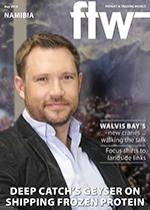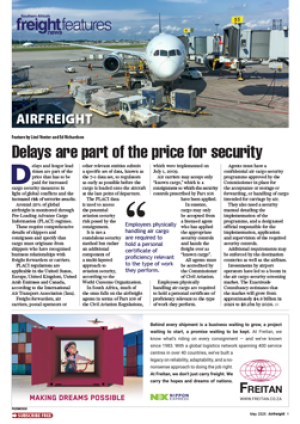Turning the Namibian railway system around is “difficult, but not impossible,” says TransNamib’s newly appointed chief executive officer Johny Smith.
“If we succeed, it will be a big plus for the country. We will have to put a significant effort in place to successfully move freight back onto rail,” he says.
The former head of the Walvis Bay Corridor Group started his working career with TransNamib, and believes he is bringing a new perspective to the more than 120-year-old Namibian railway system with his understanding of the needs of the market.
Smith’s first priority is to have viable short-, mediumand New railway boss on turnaround mission long-term plans in place in order to map out the revitalisation and expansion of the Namibian rail system which at present consists of more than 2 400 kilometres of track.
There are lines from the Nakop border with South Africa near Upington to the harbours of Lüderitz and Walvis Bay, and stretching up to Oshikango on the border with Angola. A main branch line runs from Windhoek to Gobabis, near the Botswana border.
“Our short-term goal is to stabilise the company,” says Smith. The emphasis is on optimising the use of the assets it has. There is definitely some capacity available – TransNamib was handling four million tons a year in the 1980s, and this has dropped to 1.5 million tons.
“In order to increase volumes and revenues, we are looking for the lowhanging fruit where we can get freight back onto rail.” He sees TransNamib working with shippers and freight forwarders to transport bulk cargo such as mining commodities and fuel on rail rather than road.
It is not simply a case of moving cargo from one mode to another. In order to attract cargo by helping customers to save costs and improve efficiencies TransNamib will have to develop a better understanding of how their present and potential customers operate – in order to identify opportunities that are mutually beneficial, he says. There is also some introspection.
“Rail is supposed to be cheaper than road for bulk freight in particular. Where it is not we have to identify why it is not always cheaper.” A better understanding of where TransNamib’s strengths lie will also help the company to focus on routes where it knows it is competitive given the present state of rail and available rolling stock.
Plans for the short to medium term include building dry ports at strategic junctions and rail heads such as Grootfontein, with cargo being railed between Walvis Bay and the town, and road-hauled to and from neighbouring countries. Another “low hanging fruit” could be our container depot in Windhoek.
Rail would be used for the link with Walvis Bay, and a combination of rail and road to link the depot to the rest of the region. It would save truckers a nearly 800-kilometre round-trip and would speed up turnaround times.
“We are looking for relevant partnerships to develop dry ports and transit hubs at transit points and where the rail stops,” he says. Another early priority is securing the line between the Northern Cape and Lüderitz Bay in order to attract manganese and other cargo from the region.
Plans to link Botswana to Walvis Bay through Gobabis are building up steam once again. The experience that Botswana has in operating a dry port in Walvis Bay has demonstrated the viability of using the port, he says. Long-term plans on the table include having a rail link between the Democratic Republic of Congo (DRC) and Zambian Copperbelts and Walvis Bay, as well as a rail link into Angola. At present the line stops at Oshikango, which is on the border.
INSERT
Plans for the short to medium term include building dry ports at strategic junctions and rail heads such as Grootfontein. – Johny Smith

